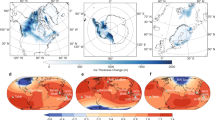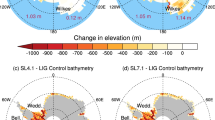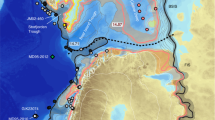Abstract
During the last deglaciation, sea levels rose as ice sheets retreated. This climate transition was punctuated by periods of more intense melting; the largest and most rapid of these—Meltwater Pulse 1A—occurred about 14,500 years ago, with rates of sea-level rise reaching approximately 4 m per century1,2,3. Such rates of rise suggest ice-sheet instability, but the meltwater sources are poorly constrained, thus limiting our understanding of the causes and impacts of the event4,5,6,7. In particular, geophysical modelling studies constrained by tropical sea-level records1,8,9 suggest an Antarctic contribution of more than seven metres, whereas most reconstructions10 from Antarctica indicate no substantial change in ice-sheet volume around the time of Meltwater Pulse 1A. Here we use a glacial isostatic adjustment model to reinterpret tropical sea-level reconstructions from Barbados2, the Sunda Shelf3 and Tahiti1. According to our results, global mean sea-level rise during Meltwater Pulse 1A was between 8.6 and 14.6 m (95% probability). As for the melt partitioning, we find an allowable contribution from Antarctica of either 4.1 to 10.0 m or 0 to 6.9 m (95% probability), using two recent estimates11,12 of the contribution from the North American ice sheets. We conclude that with current geologic constraints, the method applied here is unable to support or refute the possibility of a significant Antarctic contribution to Meltwater Pulse 1A.
This is a preview of subscription content, access via your institution
Access options
Subscribe to this journal
Receive 12 print issues and online access
$259.00 per year
only $21.58 per issue
Buy this article
- Purchase on Springer Link
- Instant access to full article PDF
Prices may be subject to local taxes which are calculated during checkout



Similar content being viewed by others
References
Deschamps, P. et al. Ice-sheet collapse and sea-level rise at the Bølling warming 14,600 years ago. Nature 483, 559–564 (2012).
Peltier, W. R. & Fairbanks, R. G. Global glacial ice volume and last glacial maximum duration from an extended Barbados sea level record. Quat. Sci. Rev. 25, 3322–3337 (2006).
Hanebuth, T., Stattegger, K. & Grootes, P. M. Rapid flooding of the Sunda shelf: A late-glacial sea-level record. Science 288, 1033–1035 (2000).
Golledge, N. R. et al. Antarctic contribution to meltwater pulse 1A from reduced Southern Ocean overturning. Nature Commun. 5, 5107 (2014).
Menviel, L., Timmermann, A., Timm, O. E. & Mouchet, A. Deconstructing the Last Glacial termination: The role of millennial and orbital-scale forcings. Quat. Sci. Rev. 30, 1155–1172 (2011).
Stouffer, R. J., Seidov, D. & Haupt, B. J. Climate response to external sources of freshwater: North Atlantic versus the Southern Ocean. J. Clim. 20, 436–448 (2007).
Weaver, A. J., Saenko, O. A., Clark, P. U. & Mitrovica, J. X. Meltwater pulse 1A from Antarctica as a trigger of the Bølling–Allerød warm interval. Science 299, 1709–1713 (2003).
Clark, P. U., Mitrovica, J. X., Milne, G. A. & Tamisiea, M. E. Sea-level fingerprinting as a direct test for the source of global meltwater pulse 1A. Science 295, 2438–2441 (2002).
Bassett, S. E., Milne, G. A., Mitrovica, J. X. & Clark, P. U. Ice sheet and solid Earth influences on far-field sea-level histories. Science 309, 925–928 (2005).
Bentley, M. J. et al. A community-based geological reconstruction of Antarctic Ice Sheet deglaciation since the Last Glacial Maximum. Quat. Sci. Rev. 100, 1–9 (2014).
Carlson, A. E. & Clark, P. U. Ice sheet sources of sea level rise and freshwater discharge during the last deglaciation. Rev. Geophys. 50, RG4007 (2012).
Tarasov, L., Dyke, A. S., Neal, R. M. & Peltier, W. R. A data-calibrated distribution of deglacial chronologies for the North American ice complex from glaciological modelling. Earth Planet. Sci. Lett. 315–316, 30–40 (2012).
Mitrovica, J. X., Tamisiea, M. E., Davis, J. L. & Milne, G. A. Recent mass balance of polar ice sheets inferred from patterns of global sea-level change. Nature 409, 1026–1029 (2001).
Fairbanks, R. G. A 17,000-year glacio-eustatic sea level record: Influence of glacial melting rates on the Younger Dryas event and deep-ocean circulation. Nature 342, 637–642 (1989).
Bard, E., Hamelin, B. & Fairbanks, R. G. U–Th ages obtained by mass spectrometry in corals from Barbados: Sea level during the past 130,000 years. Nature 346, 456–458 (1990).
Neumann, A. C. & McIntyre, I. G. Proc. 5th Int. Coral Reef Cong. Tahiti Vol. 3, 105–110 (WorldFish, 1985).
Lambeck, K., Yokoyama, Y. & Purcell, T. Into and out of the Last Glacial Maximum: Sea-level change during Oxygen Isotope Stages 3 and 2. Quat. Sci. Rev. 21, 343–360 (2002).
Blanchon, P. & Blakeway, D. Are catch-up reefs and artifact of coring? Sedimentology 50, 1271–1282 (2003).
Briggs, R. D., Pollard, D. & Tarasov, L. A data-constrained large ensemble analysis of Antarctic evolution since the Eemian. Quat. Sci. Rev. 103, 91–115 (2014).
Gomez, N., Pollard, D. & Mitrovica, J. X. A 3-D coupled ice sheet-sea level model applied to Antarctica through the last 40 ky. Earth Planet. Sci. Lett. 384, 88–99 (2013).
Whitehouse, P. L., Bentley, M. J. & Le Brocq, A. M. A deglacial model for Antarctica: Geological constraints and glaciological modelling as a basis for a new model of Antarctic glacial isostatic adjustment. Quat. Sci. Rev. 32, 1–24 (2012).
Carlson, A. E. et al. Modeling the surface mass-balance response of the Laurentide Ice Sheet to Bølling warming and its contribution to Meltwater Pulse 1A. Earth Planet. Sci. Lett. 315–316, 24–29 (2012).
Gregoire, L. J., Payne, A. J. & Valdes, P. J. Deglacial rapid sea-level rises caused by ice-sheet saddle collapses. Nature 487, 219–222 (2012).
Lambeck, K., Smither, C. & Johnston, P. Sea-level change, glacial rebound and mantle viscosity for northern Europe. Geophys. J. Int. 134, 102–144 (1998).
Simpson, M. J. R., Milne, G. A., Huybrechts, P. & Long, A. J. Calibrating a glaciological model of the Greenland ice sheet from the Last Glacial Maximum to present-day using field observations of relative sea level and ice extent. Quat. Sci. Rev. 28, 1631–1657 (2009).
Gomez, N., Gregoire, L. J., Mitrovica, J. X. & Payne, A. J. Laurentide-Cordilleran ice sheet saddle collapse as a contribution to meltwater pulse 1A. Geophys. Res. Lett. 42, 3954–3962 (2015).
Farrell, W. E. & Clark, J. A. On postglacial sea-level. Geophys. J. R. Astron. Soc. 46, 647–667 (1976).
Mitrovica, J. X. & Milne, G. A. On post-glacial sea level-I. General theory. Geophys. J. Int. 154, 253–267 (2003).
Kendall, R., Mitrovica, J. X. & Milne, G. A. On post-glacial sea level-II. Numerical formulation and comparative results on spherically symmetric models. Geophys. J. Int. 161, 679–706 (2005).
Sabadini, R., Yuen, D. A. & Boschi, E. Polar wander and the forced responses of a rotating, multi-layered, viscoelastic planet. J. Geophys. Res. 87, 2885–2903 (1982).
Milne, G. A. & Mitrovica, J. X. Postglacial sea-level change on a rotating Earth. Geophys. J. Int. 133, 1–19 (1998).
Mitrovica, J. X., Wahr, J., Matsuyama, I. & Paulson, A. The rotational stability of an ice-age Earth. Geophys. J. Int. 161, 491–506 (2005).
Mitrovica, J. X. et al. On the robustness of predictions of sea level fingerprints. Geophys. J. Int. 187, 729–742 (2011).
Dziewonski, A. M. & Anderson, D. L. Preliminary Reference Earth Model (PREM). Phys. Earth Planet. Inter. 25, 297–356 (1981).
Peltier, W. R. Global glacial isostasy and the surface of the ice-age Earth: The ICE-5G (VM2) model and GRACE. Annu. Rev. Earth Planet Sci. 32, 111–149 (2004).
Reimer, P. J. et al. IntCal13 and Marine13 radiocarbon age calibration curves 0–50,000 years cal BP. Radiocarbon 55, 1869–1887 (2013).
Clark, J. A., Farrell, W. E. & Peltier, W. R. Global changes in postglacial sea level: A numerical calculation. Quat. Res. 9, 265–287 (1978).
Acknowledgements
J.L. and G.A.M. are supported by the Natural Sciences and Engineering Research Council of Canada. G.A.M. is also supported by the Canada Research Chairs programme. R.E.K. acknowledges support from the National Science Foundation (NSF) of the United States (ARC 1203415). P.U.C. acknowledges support from the NSF Antarctic Glaciology Program (ANT1260719) and the NSF Marine Geology and Geophysics Program (OCE1335197). We thank J. Mitrovica for providing information that contributed to the work presented in this paper. This work benefited from discussions at several PALeo constraints on SEA level rise (PALSEA) workshops.
Author information
Authors and Affiliations
Contributions
J.L. performed the research and led the writing of the manuscript. G.A.M., R.E.K., P.U.C. and I.S. advised J.L. in performing the research and contributed to the writing of the manuscript.
Corresponding author
Ethics declarations
Competing interests
The authors declare no competing financial interests.
Supplementary information
Supplementary Information
Supplementary Information (PDF 1287 kb)
Rights and permissions
About this article
Cite this article
Liu, J., Milne, G., Kopp, R. et al. Sea-level constraints on the amplitude and source distribution of Meltwater Pulse 1A. Nature Geosci 9, 130–134 (2016). https://doi.org/10.1038/ngeo2616
Received:
Accepted:
Published:
Issue Date:
DOI: https://doi.org/10.1038/ngeo2616
This article is cited by
-
A reconciled solution of Meltwater Pulse 1A sources using sea-level fingerprinting
Nature Communications (2021)
-
Eurasian Ice Sheet collapse was a major source of Meltwater Pulse 1A 14,600 years ago
Nature Geoscience (2020)
-
A sea-level plateau preceding the Marine Isotope Stage 2 minima revealed by Australian sediments
Scientific Reports (2019)
-
Buried remnants of the Laurentide Ice Sheet and connections to its surface elevation
Scientific Reports (2018)
-
Antarctic ice sheet discharge driven by atmosphere-ocean feedbacks at the Last Glacial Termination
Scientific Reports (2017)



